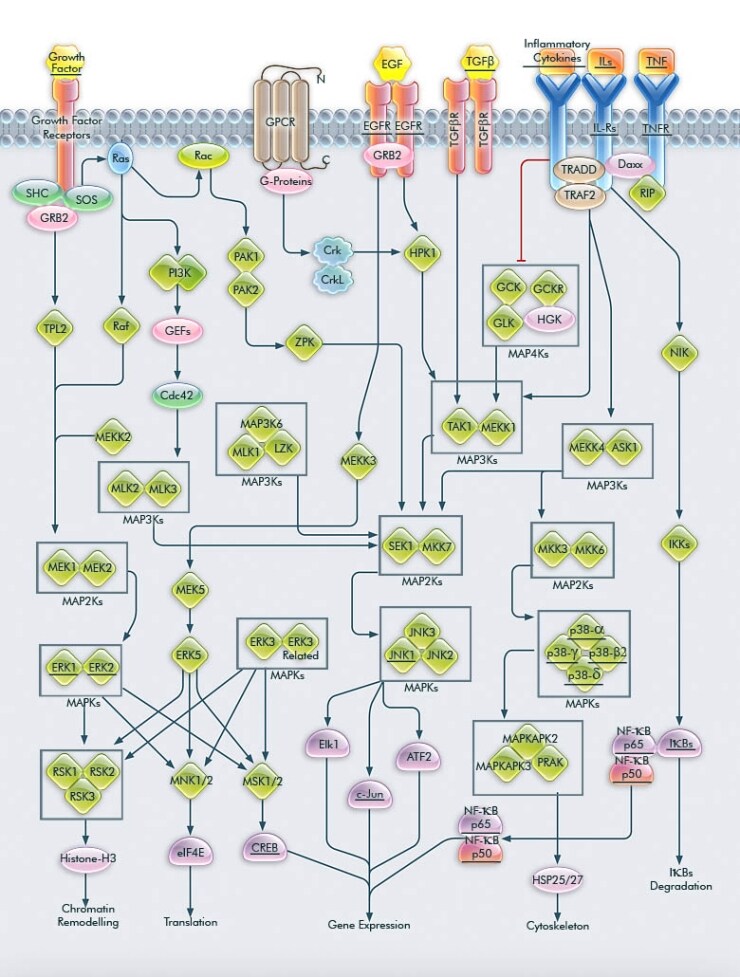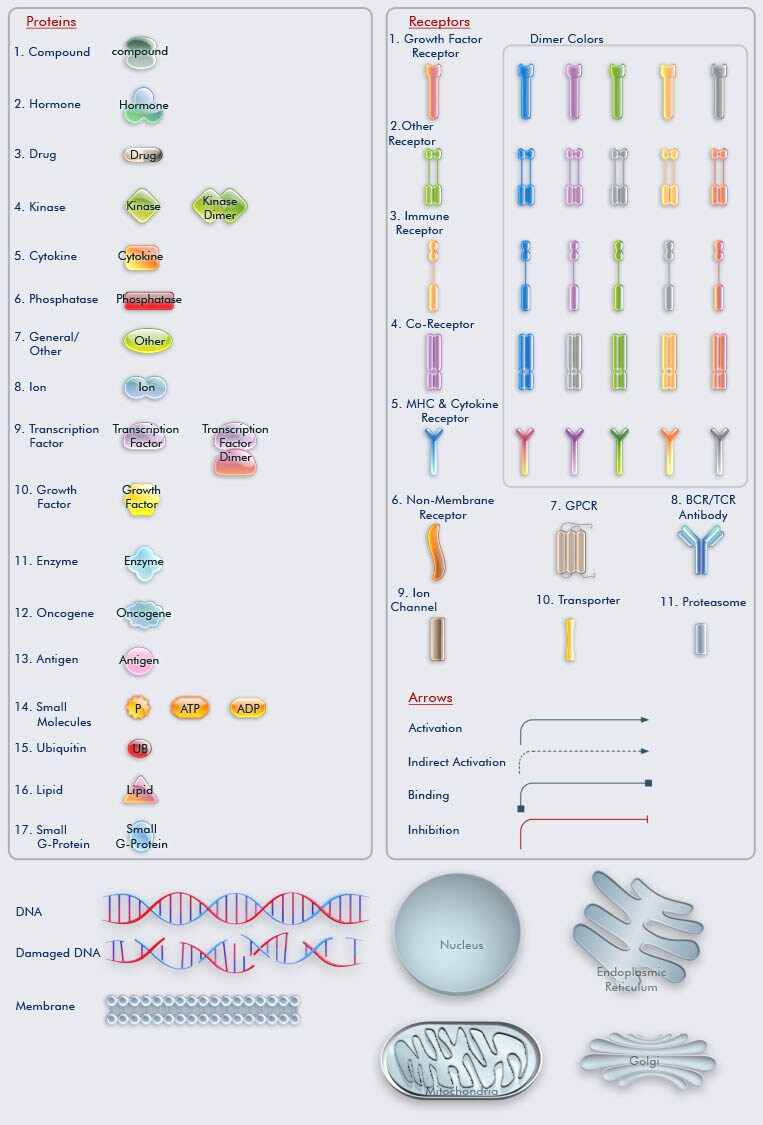Search
ERK/MAPK 家族信号通路
蛋白激酶是一种普遍存在的酶,能够通过将磷酸基团添加到其酪氨酸、丝氨酸或苏氨酸氨基酸(磷酸化)来调节其他蛋白的活性。MAPK(促分裂原活化蛋白激酶)是丝氨酸/苏氨酸蛋白激酶家族的成员,由多种信号激活,在酵母和人类等多种生物处于保守结构域 [1]。MAPK 将细胞外信号从活化受体传递到各种细胞区室(特别是细胞核),MAPK 在此引导进行激活基因转录活化、蛋白合成,细胞周期机制、细胞死亡和分化等相关的基因程序。MAPK 的特有功能在于,在受体基因发生刺激后,可通过向其酪氨酸和苏氨酸氨基酸(双磷酸化)中加入磷酸基团来激活 MAPK 自身。哺乳动物细胞的 MAPK 通路通过各种不同的刺激因子激活,这些因子通过以下多种受体家族发挥作用:通过受体酪氨酸激酶发挥作用的激素和生长因子[例如:胰岛素、EGF(表皮生长因子);PDGF(血小板衍生生长因子);FGF(成纤维细胞生长因子)或细胞因子受体(例如生长激素);通过 G 蛋白偶联的七穿膜受体发挥作用的血管活性肽(例如 ANGII 和内皮素);通过丝氨酸-苏氨酸激酶发挥作用的 TGF-Beta(转化生长因子 )相关多肽;TNF(肿瘤坏死因子)家族的炎性细胞因子以及环境应激(例如渗透压冲击、电离辐射和缺血性损伤)。MAPK 在由三种蛋白激酶组成的模块中工作,其中磷酸化和激活相互作用顺序如下:MAPKKK(MAP 激酶激酶激酶)激活 MAPKK(MAP 激酶激酶),然后后者激活 MAP 激酶。目前,在哺乳动物细胞中可鉴定至少 14 个 MAPKKK,7 个 MAPKK 和 12 个 MAPK。这些激酶模块在复制发生的变异极小,从而让细胞通过一组 MAP 激酶连接网络刺激多个生物反应。在哺乳动物细胞中,有三个 MAPK 家族发生充分表征:典型 MAPK,也称为 ERK(细胞外信号调节激酶)、JNK/SAPK (C-JUN N 端激酶/应激激活蛋白激酶)和 p38 激酶 [2,3]。
JNK/SAPK 信号转导通路是由不同水平的 MAPK 组成的激酶级联反应。SAPK 至少由三个基因进行编码:SAPK-Alpha/JNK2、SAPK-Beta/JNK3 和 SAPK-Gamma/JNK1。与所有 MAPK 一样,在蛋白激酶催化结构域的子结构域 VIII 中,每个 SAPK 同源异构体包含表征 Thr-X-Tyr 磷酸化受体环。在 MAPK 激酶 (MAP2K) 水平上,JNK 上游直接形成两种双特异性激酶,可在丝氨酸和苏氨酸残基处将 JNK 磷酸化并活化 JNK。这些激酶是 MKK4(MAPK 激酶 4)和 MKK7。这些蛋白依次由上游 MAP3K 进行活化:MEKK(MAPK/ERK 激酶激酶)、MLK2/3(混合谱系激酶 2/3)、TAK1(TGF-β 活化激酶 1)、TPL2(肿瘤进展位点 2)、ZPK(拉链蛋白激酶)和 ASK1(细胞凋亡信号调节激酶 1)。还确定了部分其他 MAP3K,但其功能未知。包括 MAP3K6、MLK1 和 LZK(亮氨酸拉链激酶)[4]。最近,识别并表征了一组与 Ste20 激酶同源的 MAP4K(参与酿酒酵母中信息蛋白酶反应通路的 MAPK 级联的上游成员)。这些 MAP4K 蛋白为 MAPK/JNK 信号级联提供了其他水平的调节性蛋白,并可能是与质膜相互作用或位于质膜上的调节性蛋白的链接。MAP4K 家族包括:HPK1(造血祖细胞激酶 1)、GCK(生发中心激酶)、GLK(GCK 样激酶)、HGK(HPK/GCK 样激酶)、与 Ste20/SPS1 同源的激酶和 GCKR(GCK 相关激酶)。HPK1 是 97kDa 的丝氨酸/苏氨酸激酶,属于蛋白激酶的 HPK1/GCK 亚家族。HPK1 在 JNK 激酶级联中的 MEKK1 和 TAK1 上游。HPK1 通过与这些蛋白质的 SH3(Src 同源结构域 3)结合,与适配体蛋白(例如:Crk、CrkL、GRB2(生长因子受体结合蛋白 2)和 NCK 相关联。此外,HPK1 与这些蛋白的结合增强了 HPK1 的激酶活性及其与 EGF 受体的结合。GCK、GCKR、GLK 和 HGK 等其他 MAP4K 都被 TNF 活化。与 MEKK1 和 MLK 一样,GCK、GCKR 和 HGK 是特异性 JNK 激活因子。JNK 信号转导通路与多种生理过程有关。JNK 作为二聚体形式时具有活性,可以易位到细胞核膜中。JNK 最初确定为 c-Jun 磷酸化的主要激酶,导致 AP1(激活因子蛋白 1)转录因子的活性增加;其他细胞核转录因子也已知为靶标,包括 ATF2(激活转录因子 2)、Elk1、Myc、SMAD3(SMA 和 MAD 相关蛋白 3)、肿瘤抑制剂 p53、NFAT4(激活因子 T 细胞的核因子)、DPC4(胰腺癌缺失基因 4)以及 MADD(MAP 激酶激活死亡结构域,即细胞死亡结构域蛋白)。JNK 调节转录因子有助于调节多种细胞刺激物(包括应激事件、生长因子和细胞因子)的基因表达。JNK 信号级联反应的激活通常会导致细胞凋亡,尽管也其也可在某些条件下促进细胞存活,并且在后生动物发育过程中确定细胞命运以及参与肿瘤发生和炎症中发挥重要作用 [5,6]。
p38 MAPK 是第二中哺乳动物细胞应激活化 MAPK 家族。哺乳动物 p38 MAPK 家族由细胞应激活化,包括紫外辐照、热休克、高渗透压、脂多糖、蛋白合成抑制剂、促炎细胞因子(例如:IL-1 和 TNF- α)和某些促分裂原。至少已确定 p38 的四种同源异构体,为 p38 α、p38 β、p38 γ 和 p38/Delta,它们均能通过 MAPK 激酶 MKK6 进行磷酸化。其他 MAPKK 可能使某些 p38 同源异构体磷酸化。MKK3 可以激活 p38 α、p38 γ 和 p38 Delta。MKK4 可激活 p38 α。TAK1 是一种新型 MAPKKK。它参与 TGF β 的信号转导和 p38 激酶通路的磷酸化。p38 的 α 和 β 同源异构体负责 HSP25/27(热休克蛋白 25/27)和 MAPKAPK2(MAPK 激活蛋白激酶 2)的活化。p38 的 γ 和 Delta 同源异构体能活化 ATF2。受 p38 家族影响的其他转录因子包括 STAT1(信号传导及转录活化因子 1)、Maxc-Myc 复合物、Elk-1 和通过 MSK1(促分裂原和应激活化激酶 1)活化的 CREB(cAMP 反应元件结合蛋白)。因此,p38 亚家族也参与对细胞运动、转录和染色质重构的影响。p38 信号转导通路的其他底物包括用于调节基因表达的 CHOP(C/EBP 同源蛋白)以及 MAPKAPK3、MAPKAPK5 和 MNK1(MAPK 相互作用激酶 1)。p38 MAPK 是 TNF 诱导的 NF-κB 依赖性基因活化的关键介质。TNF 诱导的 p38 MAPK 活化独立于与 TRAF2(TNF 受体相关因子 1)相关的 NIK(NF-κB 诱导激酶)(一种其他的 MEKK,已知可结合和激活两种最近识别的 IKK(IκB 激酶)[7,8]。
胰岛素/促分裂原调节 ERK 通路实际上是第一种识别的哺乳动物细胞 MAPK 通路 [9]。ERK 模块主要对生长因子和促分裂原作出反应,并刺激细胞核内的转录反应。基团中研究较佳的 ERK1 和 ERK2 被 MEK1(MAPK/ERK 激酶 1)和 MEK2 活化,后者在 Thr-Tyr 基序处磷酸化。随后,MEK 被 c-Raf(此信号转导通路的 MAPKKK)活化,MAPKKK 反之受到生长因子受体和通过 Ras 活化的酪氨酸激酶调节。在膜上,Raf 也被多种蛋白激酶(酪氨酸激酶、酪氨酸激酶和丝氨酸/苏氨酸激酶、PAK(p21 活化激酶)(Rac1(Rho 家族 GTP 酶,本身是 Ras 效应物)的效应物)磷酸化。Ras 本身可通过吸收 Raf1 直接影响 ERK 通路,至少部分应激活化 MAPK 核心通路可被 Ras 超家族的 Rho 亚家族成员调节。Rho 亚家族包括哺乳动物细胞中 Rho、Rac 和 CDC42(细胞分裂周期 42)基团。PI3K(磷酸肌醇-3-激酶)的活化需要 Ras,因此,Rho 家族 GEF 本身可能被 Ras PI3K 调节。实际上,Rac1 的促分裂原活化需要 PI3K 活化。MEKK2 和 MEKK3 属于其他 MAP3K,也可以活化 MEK1 和 SEK1(SAPK/ERK 激酶 1)。TPL2 也可以活化促分裂原 ERK。TPL2 属于 MAP3K,可以直接活化 MEK1 和 SEK1。当过度表达全长 TPL2 活化 SAPK 和 ERK 时,致癌性 COOH 末端截短 TPL2 表达显著提高了 SAPK 和 ERK 活化,从而进一步支持 COOH 末端域对 TPL2 活性产生负面调节的论点。在向细胞核转位后,ERK 负责对多种底物进行磷酸化,具体取决于初始刺激。这些包括转录激活因子,包括 p90 RSK S6 激酶、MAPKAPK1(MAPK 激活蛋白激酶 1)、磷脂酶 A2 和 MSK,以及转录因子(Elk1、Ets1、Sap1a 和 m-Myc)、STAT 蛋白(例如:STAT3)、衔接蛋白(例如:SOS,无七之子)、生长因子受体(例如:EGF)和雌激素受体。通常,ERK 信号转导通路激活在介导细胞分裂、迁移和存活中发挥作用。ERK1/2 和 MEK1/2 在肌肉运动期间也可被强烈激活,并且在运动与骨骼肌成分的适应性变化之间存在联系(参考 10)。除了上述列举的 MAPK 通路外,还识别了其他 MAPK 家族。其中一种是 BMK1(大促分裂原活化蛋白激酶,也称为 ERK5),是最近确定的哺乳动物细胞中 MAPK 家族的成员。BMK1 被生长因子、氧化应激和高渗性状态激活。由 MEKK3 激活的 MEK5 是 BMK1 的特异性上游激酶。还确定了另外两个 ERK(ERK3 和 ERK3 相关),但其功能未知。MAP 激酶信号转导通路通过共享底物和交叉级联相互作用,在哺乳动物细胞的增殖调节中发挥重要作用。MAP 激酶通路涉及许多病況,包括癌症和其他疾病。因此,更好地了解 MAP 激酶信号转导系统和细胞增殖调节之间的关系,对于新型药理学方法的合理设计至关重要 [8,10]。
通路

图例

抗体资源库
有针对性地收集科学应用说明、方法和细胞信号图。
相关产品
- Alam R, Gorska MM (2011) Mitogen-activated protein kinase signalling and ERK1/2 bistability in asthma. Clin Exp Allergy 41(2):149-59.
- Broom OJ, Widjaya B, Troelsen J, et al.(2009) Mitogen activated protein kinases: a role in inflammatory bowel disease? Clin Exp Immunol 158(3):272-80.
- Aoki K, Yamada M, Kunida K, Yasuda S, Matsuda M. (2011) Processive phosphorylation of ERK MAP kinase in mammalian cells. Proc Natl Acad Sci U S A 108(31):12675-80.
- Raman M, Chen W, Cobb MH (2007) Differential regulation and properties of MAPKs. Oncogene 26(22):3100-12.
- Manna PR, Stocco DM (2011) The role of specific mitogen-activated protein kinase signaling cascades in the regulation of steroidogenesis. J Signal Transduct 2011:821615.
- Wada T, Penninger JM (2004) Mitogen-activated protein kinases in apoptosis regulation. Oncogene 23(16):2838-49.
- Kostenko S, Dumitriu G, Lægreid KJ, et al.(2011) Physiological roles of mitogen-activated-protein-kinase-activated p38-regulated/activated protein kinase. World J Biol Chem 2(5):73-89.
- Shiryaev A, Moens U (2010) Mitogen-activated protein kinase p38 and MK2, MK3 and MK5: ménage à trois or ménage à quatre? Cell Signal 22(8):1185-92.
- Komis G, Illés P, Beck M, et al.(2011) Microtubules and mitogen-activated protein kinase signalling. Curr Opin Plant Biol 14(6):650-7.
- Cargnello M, Roux PP (2011) Activation and function of the MAPKs and their substrates, the MAPK-activated protein kinases. Microbiol Mol Biol Rev 75(1):50-83.
